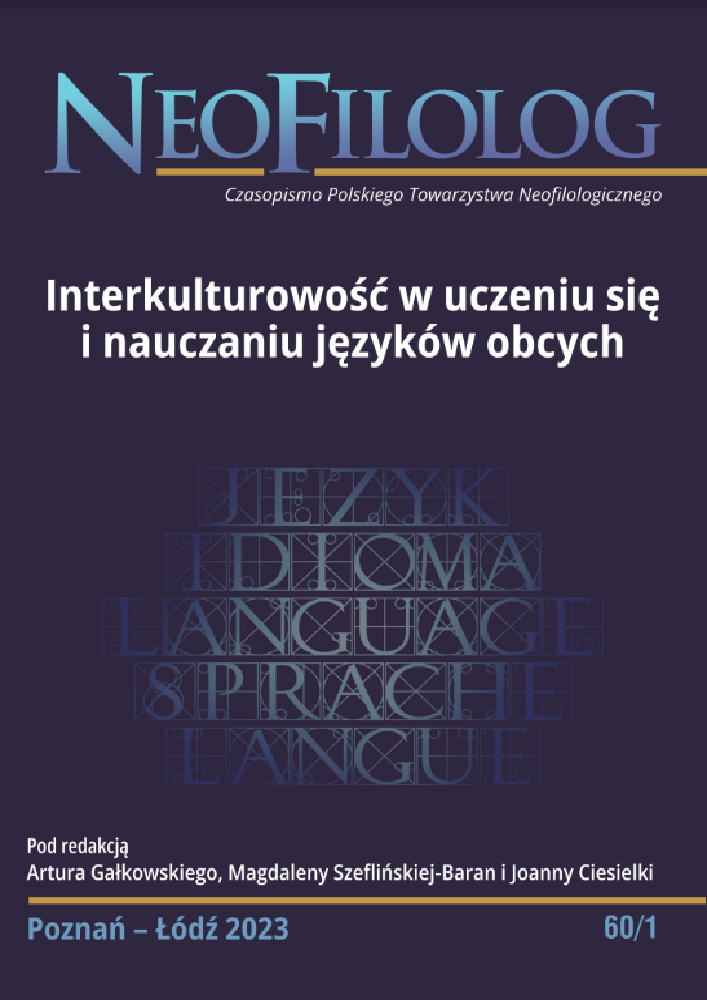Résumé
The topic of the article is phraseology analyzed from the perspective of didactics and translation. The author presents phraseology as a subject of research and shows its development over time. In the mid-twentieth century, the scope of phraseology mainly encompassed traditional, well-established expressions, such as pictorial phraseologisms, idioms or proverbs. At present, the concept of phraseology has grown significantly, and the research of phraseologists often focuses on structures not typical of traditional phraseology, such as, for example, collocations, multi-word specialist terminology, or reproducible conversational formulas, also known as pragmatemes. In the second part of the text, the author describes the research. Its aim was to find out to what extent philology students are familiar with frequently used pragmatemes. The study was conducted among students of Romance philology at the University of Silesia and covered 50 people. The study used 15 pragmatemes that are often used in modern French communication. The author presents a quantitative and qualitative analysis of the research. It also presents synthetic conclusions that are important in the context of didactics and translation.
Références
Chlebda W. (1989), Teoria frazeologiczna a nauczanie języka obcego. „Prace Językoznawcze”, nr 15, s. 96-108.
Chlebda W. (2003), Elementy frazematyki. Wprowadzenie do frazeologii nadawcy. Łask: Oficyna Wydawnicza Leksem.
Krzyżanowska A., Grossmann F., Kwapisz-Osadnik K. (red.) (2021), Les formules expressives de la conversation. Analyse contrastive : français-polonais-italien. Lublin: Wydawnictwo Episteme.
Lewicki A.M. (1976), Wprowadzenie do frazeologii syntaktycznej. Teoria związku frazeologicznego. Katowice: Prace Naukowe UŚ, nr 116.
Lewicki A.M. (1983), Składnia związków frazeologicznych. „Biuletyn PTJ”, z. XL, s. 75-83.
Lewicki A.M. (1999), Od przysłowia do frazeologizmu, (w:) Banyś W., Bednarczuk L., Karolak S. (red.), Studia Lingwistyczne ofiarowane prof. K. Polańskiemu na 70-lecie Jego Urodzin. Katowice: Wydawnictwo UŚ, s. 157-163.
Lewicki A.M. (2003), Studia z teorii frazeologii. Łask: Oficyna Wydawnicza Leksem.
Müldner – Nieckowski P. (2007), Frazeologia poszerzona. Warszawa: Oficyna Wydawnicza Volumen.
Skorupka S. (1969), Podstawy klasyfikacji jednostek frazeologicznych. „Prace Filologiczne”, v. XIX, s. 219-226.
Szutkowski T. (2019), Subkompetencja frazeologiczna studentów-neofilologów jako składnik kompetencji językowej tłumacza. Badanie pilotażowe. „Roczniki Humanistyczne”, t. LXVII, zeszyt 7, s. 93-111. DOI: https://doi.org/10.18290/rh.2019.67.7-6
Licence
© Monika Sułkowska 2023

Ce travail est disponible sous licence Creative Commons Attribution - Pas de Modification 4.0 International.
Auteurs :
Les auteurs de textes acceptés pour publication dans la revue Neofilolog sont tenus de remplir, signer et renvoyer à l'adresse de la rédaction, un accord sur l'octroi d'une licence gratuite pour les œuvres, avec obligation d'accorder une sous-licence CC.
En vertu de cet accord, les auteurs des textes publiés dans la revue Neofilolog accordent à l'Université Adam Mickiewicz de Poznań une licence non exclusive et gratuite et permettent l'utilisation de la sous-licence Creative Commons Attribution-NoDerivatives 4.0 International (CC BY-ND 4.0).
Les auteurs se réservent le droit de disposer librement de l'œuvre.
Utilisateurs :
Les utilisateurs d'Internet intéressés ont le droit d'utiliser les œuvres publiées à partir de l'année 2017 sous réserve des conditions suivantes :
- reconnaissance de la qualité d'auteur - l'obligation de fournir des informations sur la qualité d'auteur, le titre, la source (liens vers l'œuvre originale, DOI) et la licence, ainsi que l'œuvre distribuée ;
- sans créer d'œuvres dérivées - l'œuvre doit être conservée dans sa forme originale, p. ex. les traductions ou les interprétations ne peuvent être distribuées sans le consentement de l'auteur.
Tous les textes publiés sont soumis au droit d'auteur.
Autres :
L'Université Adam Mickiewicz de Poznań se réserve le droit à la revue dans son ensemble (mise en page, forme graphique, titre, conception de la couverture, logo, etc.).
.

